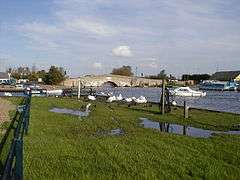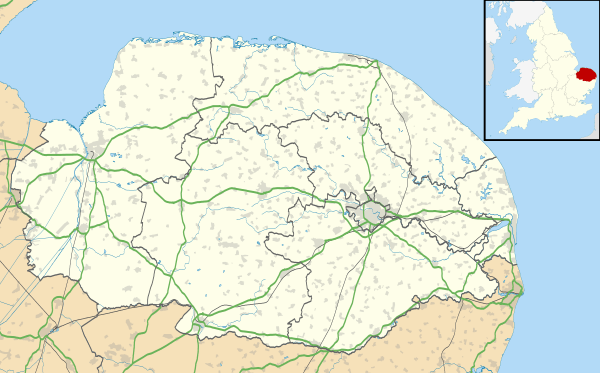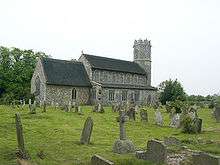Potter Heigham
Potter Heigham is a village and civil parish on the River Thurne in the English county of Norfolk. It is situated 12 mi (19 km) north-east of the city of Norwich on the A149 road, and within the Broads.[2]
| Potter Heigham | |
|---|---|
 Potter Heigham's medieval bridge | |
 Potter Heigham Location within Norfolk | |
| Area | 10.38 km2 (4.01 sq mi) |
| Population | 1,043 (2011)[1] |
| • Density | 100/km2 (260/sq mi) |
| OS grid reference | TG415193 |
| Civil parish |
|
| District | |
| Shire county | |
| Region | |
| Country | England |
| Sovereign state | United Kingdom |
| Post town | GREAT YARMOUTH |
| Postcode district | NR29 |
| Police | Norfolk |
| Fire | Norfolk |
| Ambulance | East of England |
The village is known for its mediaeval bridge and the Church of St Nicholas. There are two national nature reserves within the parish; the Ludham - Potter Heigham NNR is to the west of the village whilst the Heigham Holmes NNR is to the east. The Weavers Way, a long distance footpath, also passes through the village on its way from Cromer to Great Yarmouth.
History
The parish of Potter Heigham (pronounced locally as Ham) has a number of features related to the World Wars. Hickling Broad, to the north of the parish, was used as a seaplane base during World War I. Part of Ludham Airstrip, a now shrunken remnant of a larger World War II airbase, is also built on parish lands, and there were a number of defensive structures around the medieval bridge.
The Museum of The Broads was opened in Potter Heigham in 1996, and moved to its current location at the Poor’s Staithe in Stalham in 1999.[3]
Government
The civil parish has an area of 10.38 km2 (4.01 sq mi) and in the 2001 census had a population of 961 in 425 households, the population increasing to 1,043 at the 2011 Census. For the purposes of local government, the parish falls within the district of North Norfolk and the county of Norfolk.[4]
As in other broadland villages, the areas adjacent to the river fall under the administration of the Broads Authority.
Main sights
Apart from the church of St Nicholas and the medieval bridge, Potter Heigham has a number of buildings of historic or architectural note. These include the Heigham Holmes windpump to the east of the parish, High's mill on the River Thurne,[5] and Sunways corn mill,[6] all of which are listed buildings. The village is home to Lathams of Potter Heigham, a department store opened in 1964, but now owned by the QD Stores group.[7]
Church of St Nicholas

Potter Heigham church is dedicated to St Nicholas, the patron saint of fishermen and children. The earliest surviving feature is the round tower, which dates from the 12th century and has a 14th-century octagonal extension, one of the best preserved in the country.[5]
It is famed for its hammerbeam roof and the almost unique 15th-century brick font.[8] The church also contains a scheme of wall paintings dating from the 14th century, the most readable of which depicts the Seven Works of Mercy.[9] When the roof was re-thatched it required about 1850 bundles of reed. It is one of 124 existing round-tower churches in Norfolk. The church is a Grade I listed building.[10]
Potter Heigham Bridge
Potter Heigham Bridge is a medieval bridge, believed to date from 1385, famous for being the most difficult to navigate in the Broads. The bridge opening is so narrow that only small cruisers can pass through it, and then only at low water, usually with the help of resident pilots at Phoenix Fleet boatyard next to the Bridge - there is a fee of £20 - £10 each way for holiday craft in the summer. Hire boats from the main agencies pay 50%, i.e. £10 for both trips. A modern roadbridge is close by.
Folklore
A tale is told that in 1742 Lady Carew and her daughter Evelyn were taken away on Evelyn's wedding day by a phantom coach driven by skeletons. The coach reportedly caught alight as it crossed Potter Heigham bridge. It is also said that the ghost of a drummer boy skates across the Broad during the month of February.[11]
Notable people
- The Norfolk humourist Sidney Grapes lived and worked in Potter Heigham. He was famous for his collection of Norfolk dialect letters entitled The Boy John Letters, which were originally published in the Eastern Daily Press.
- Arthur Ransome set his books Coot Club and The Big Six in the Norfolk Broads, and Potter Heigham features as a location in both.
Notes
- "Parish population 2011". Retrieved 3 September 2015.
- Ordnance Survey (2005). OS Explorer Map OL40 - The Broads. ISBN 0-319-23769-9.
- Stone, Andrew (28 October 2017). "Museum of the Broads ends 21st birthday celebrations with family fun day and prize draw". Eastern Daily Press. Retrieved 13 March 2019.
- Office for National Statistics & Norfolk County Council (2001). Census population and household counts for unparished urban areas and all parishes Archived 2017-02-11 at the Wayback Machine. Retrieved December 2, 2005.
- Pevsner, N. and Wilson, B. (1991). The Buildings of England. Norfolk 2: North-West and South, London: Penguin Books.
- Neville, J. (2004).Potter Heigham towermill, Retrieved December 08 2006.
- Dunford, Martin; Lee, Phil (2012). The Rough Guide to Norfolk & Suffolk. Rough Guides UK. p. 83. ISBN 978-1-84836-606-0.
- Mortlock D. P. & Roberts, C. V. (1981) The Popular Guide to Norfolk Churches No. 1, North-East Norfolk . Acorn Editions.
- Marshall, A. The Seven Works of Mercy, Potter Heigham, Norfolk. Retrieved December 08, 2006
- "Images of England".
- "Potter Heigham". Literary Norfolk. Retrieved 22 August 2014.
External links
| Wikimedia Commons has media related to Potter Heigham. |
| Wikivoyage has a travel guide for Potter Heigham. |
- Map sources for Potter Heigham.
- Information from Genuki Norfolk on Potter Heigham.
- Website with photos of Potter Heigham St. Nicholas, a round-tower church
- Southall, A. (2006).'A Vision of Britain Through Time: Potter Heigham CP'